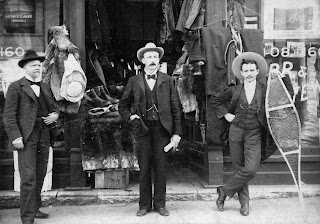Well, here we are again. A month and a half away from the January Ham shoot, and a few months away from the annual Maple Sugar Camp. I am really excited and it's nice to have these things to look forward to. The ham is about to be ordered, the whiskey is being picked out by our expert in that field, member Brian Cushing and I'm looking to order some labels from a company in England that make period canned good labels.
What else am I doing?
Working on getting my coon hunting kit together. Since the beginning of reading "Back Then" and pouring through the HTT magazines, it's been my favorite subject. Back home my Amish neighbor and I would go coon hunting and as far as hunting goes, it's been my favorite. Unlike deer hunting or other bigger game where you spend the whole time sitting still, coon hunting allows you to pursue the game.
It's such a wonderful rush that you get when you hear the dog has something treed. I have never hunted with hounds. My neighbor I mentioned before had an Australian Heeler that was one of the best. When he had treed the coon, he would begin to whimper and cry real loud. We'd come up on him and shine. Sure enough we'd see those two glowing eyes looking down on us.
EQUIPMENT :
The equipment for coon hunting is pretty basic. You need light, a firearm and a dog.
We will start with light.
Some coon hunters during the early 20th century were using carbide lamps however for me it will much easier to use a kerosine lantern.
I'm really excited to see how hunting with a lantern like this will work. Obviously it does work, because they did it, but I've never experienced it before.
Now to the firearm.
The only gun you need is a good single shot .22 . My good friend and member Matthew Fennewald recently said if he could only choose one gun to own, it would be a .22 . So which one will I be taking? Stevens single shot.
It's a great little gun and provides just the right amount of fire power. I recently took a ground hog with it, and from 40 yards I dropped it like a hammer.
My dog.
The dog, a Plott/Cur is a young one, but I'm hoping he'll take to hunting. He's shown a lot of promise when I've taken him to the woods. Nose to the ground, head looking up, jumping up on trees. Everyone says to take your dog out with other dogs, but I don't know anyone around here so I'm just going to have to give it a go.
Wish me luck. I'm looking forward to getting out in the dark and chasing the ring tails again.
-Jake Book, Member 002


































